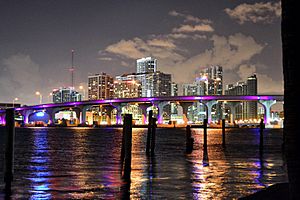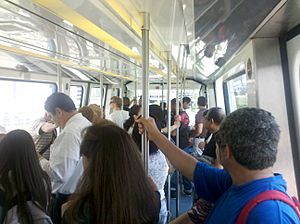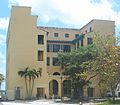- This page was last modified on 17 October 2025, at 10:18. Suggest an edit.
Arts & Entertainment District facts for kids
|
Arts & Entertainment District
|
|
|---|---|
|
Neighborhood of Miami
|
|

The Arts & Entertainment District viewed at night in May 2011 from Watson Island
|
|

Arts & Entertainment District within the City of Miami
|
|
| Country | United States |
| State | Florida |
| County | Miami-Dade County |
| City | Miami |
| Population
(2010)
|
|
| • Total | 11,033 (District population only) 71,000 (Greater Downtown population) |
| • Density | 20,585/sq mi (7,948/km2) |
| Time zone | UTC-05 (EST) |
| ZIP Code |
33132
|
| Area codes | 305, 786 |
| Website | Miami Arts & Entertainment District |
The Arts & Entertainment District is a lively neighborhood in Miami, Florida. It was once known as Omni. This area is part of Greater Downtown Miami. It is located just south of Edgewater.
The district is bordered by North 19th Street to the north. North 10th Street is its southern border. To the west is North East 2nd Avenue. Biscayne Boulevard forms its eastern edge. This neighborhood is very urban. It has many tall residential buildings. You can also find older, historic buildings here.
The Arts & Entertainment District is home to important places. These include the Adrienne Arsht Center for the Performing Arts. The old Miami Herald newspaper headquarters was also here. It is now in Doral. The Omni International Mall is another key spot. Until 2014, the annual Miami International Boat Show was held at the Sea Isle Marina. Miami's oldest cemetery, the City of Miami Cemetery, is also in this district. You can also find the historic Women's Club. Some of Miami's oldest churches and synagogues are located here too.
You can get around the Arts & Entertainment District easily. The Metromover system serves the area. It has an Omni Loop branch. You can also connect to the Metrorail at Government Center.
Contents
Exploring the Arts & Entertainment District's Past
From the 1920s to the 1950s, the Omni area was a popular shopping spot. Many large department stores lined Biscayne Boulevard. Stores like Sears, Roebuck and Company were here. Its tower still stands near the Arsht Center. Jordan Marsh and Burdines also had stores here.
By 1930, this part of Biscayne Boulevard was home to the Sears store. The Shrine Building was also built then. These buildings were designed in the Art Deco style. The area from NE 13th to NE 16th Street was planned as a fancy shopping district. Early businesses in the Shrine Building included a Piggly-Wiggly grocery store. There was also an electric company and a piano store.
In 1977, the Omni International Mall opened. It replaced many street-side shops. The mall brought luxury stores like Emilio Pucci and Hermes. But by the 1990s, the mall started to struggle. Jordan Marsh closed in 1991. JC Penney closed in 1998. The mall shut down in 2000. In 2007, it was turned into offices. Today, it houses offices and the Miami International University of Art and Design. The Greater Miami Chamber of Commerce is also based here. The neighborhood's name, Omni, comes from this mall.
In the 2000s, many new tall residential buildings were built. This helped to bring new life to the neighborhood. The area around Margaret Pace Park grew a lot between 2000 and 2010. Today, Omni has many residents. New shops and homes are still being built. This has helped it become a unique part of Miami.
Learning in the Arts & Entertainment District
The district has several educational places:
- Miami-Dade County Public Schools
- Miami International University of Art and Design, a private college
- Aspira of Florida Charter School, a public charter school
Getting Around the Arts & Entertainment District

Metromover is a popular way of getting around the Downtown area. It connects the area's neighborhoods and can get very busy during rush hour.
The Metromover train system has three lines in Downtown Miami. These are the Downtown Loop, the Omni Loop, and the Brickell Loop. The Metromover connects with the Metrorail and is free to ride. There are two Metromover stations in this district. They are School Board Station and Adrienne Arsht Center.
You can transfer to the Metrorail at Government Center. The Metrorail is Miami's heavy rail system. It has stops all over Miami. You can connect to Miami International Airport. You can also connect to all Miami-Dade County bus lines. Tri-Rail and Amtrak connections are also available. The main bus station is near the Arsht Center. It is at the Adrienne Arsht Center station.
The Arts & Entertainment District is served by Metrobus. It is also served by the Miami Metrorail and the Metromover.
Metrorail:
- Government Center (NW First Street and First Avenue)
Metromover:
- Omni Loop
This area is very pedestrian-friendly. It has a great public transit system. Many people here do not need a car. They walk, bike, or use the Metromover. The Metromover is a popular choice. It is free and has stations every two blocks. This is great on hot or rainy days.
The City of Miami is also working on bike-friendly projects. They are adding more bike parking and bike lanes. This makes bicycling more popular. Bike lanes and bike sharrows are planned for most Downtown streets. The Venetian Causeway is a popular bike route. It connects South Beach to Omni. The Rickenbacker Causeway is also popular for bikes on weekends. Sometimes, there are more bikes than cars there!
Green Spaces in the District
- Margaret Pace Park
- City of Miami Cemetery
Historic Buildings in Omni
Even though it's one of Miami's oldest areas, not many original buildings remain. Here are some historic buildings you can still see:
-
The historic Miami Women's Club, built in 1926.
-
First Church of Christ, Scientist, built in 1925.
-
Trinity Episcopal Cathedral, built in 1925.
-
The Sears Department Store Tower at the Arsht Center, built in 1929.
Places to Visit
|
|
Images for kids
-
The district skyline as seen from Biscayne Bay to the east















